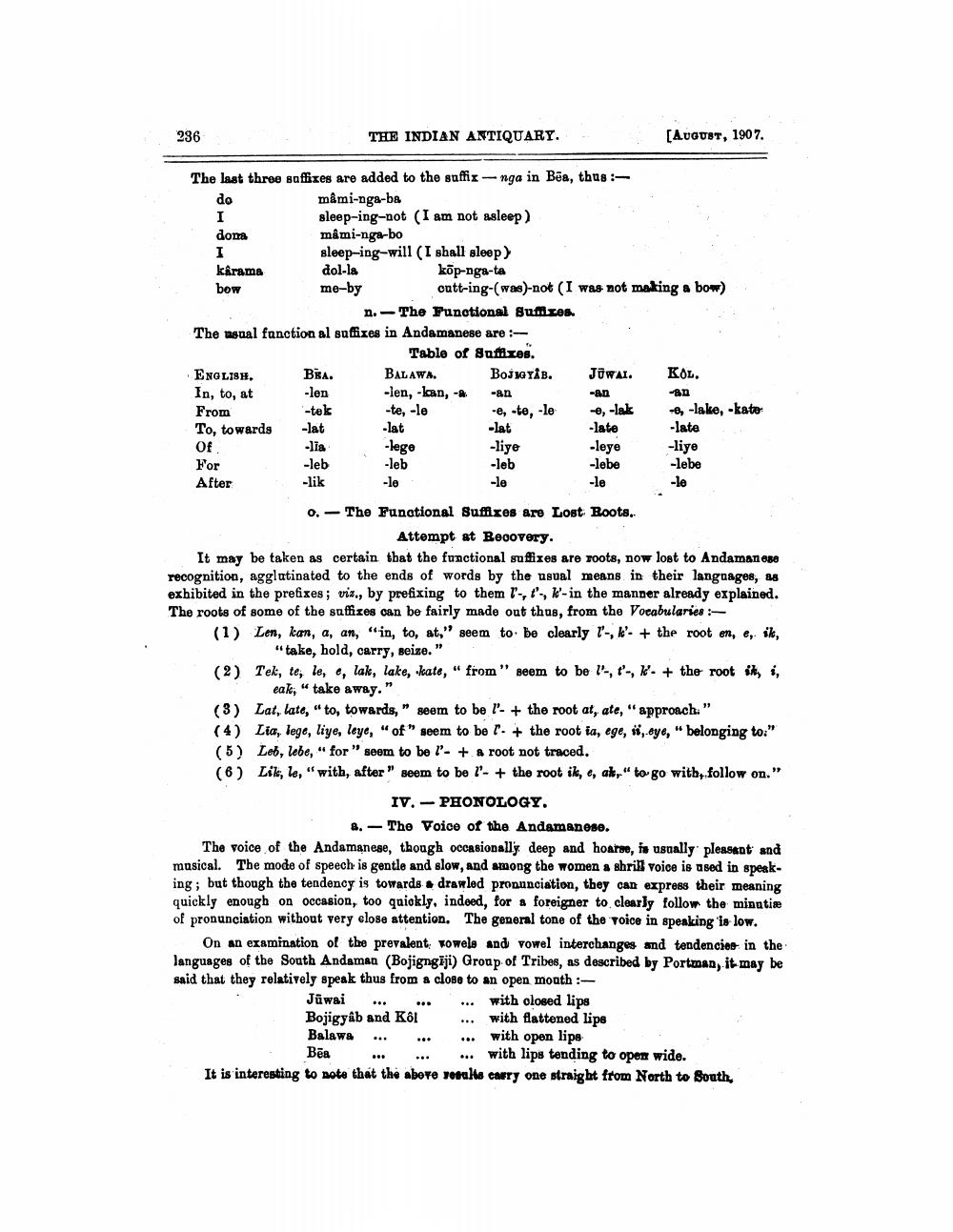________________
236
THE INDIAN ANTIQUARY.
[AUGUST, 1907.
BEA.
-lik
-le
le
The last three suffixes are added to the suffix - nga in Boa, thus :do
mâmi-nga-ba
sleep-ing-not (I am not asleep) doma
mâmi-nga-bo
sleep-ing-will (I shall sleep) karama dol-la
kop-nga-ta bow me-by
outt-ing-(was)-not (I was not making a bow)
n. - The Functional Sumises. The usual function al suffixes in Andamanese are :
Table of Suffixes. ENGLISH. BALAWA. BOJITIB. Jiwa.
KOL. In, to, at -len -len, -Lan, -
-An From -tek -te, -le -e, -te, -le
-e, -lak
-2, -lake, -kate To, towards -lat -lat
-lat
-late -late Of
lia -lege
-liye
-leye -liye For -leb -leb
-leb
-lebe -lebe After
-lo 0.- The Functional Suffixes are Lost Boots..
Attempt at Beoovery. It may be taken as certain that the functional suffixes are roots, now lost to Andaman esa recognition, agglutinated to the ends of words by the usual means in their languages, as exhibited in the prefixes; vit., by prefixing to them ', t' k'- in the manner already explained. The roots of some of the suffizes can be fairly made out thus, from the Vocabularies :(1) Len, kan, a, an, “in, to, at," seem to be clearly i'-, l' + the root en, e, sk,
"take, hold, carry, seize." (2) Tek, te, le, e, lak, lake, kate," from " seem to be 1'-, t'-, K. + the root ik, i,
eak," take away." (3) Lat, late, "to, towards," seem to be l'- + the root at, ate," approach." (4) Lia, lege, liye, leye, "of" seem to be t- + the root ia, ege, eye, " belonging to." (5) Leb, lebe," for " seem to be I'- + A root not traced. (6) Lik; le, "with, after" seem to be l'- + the root ik, e, ak," to go with, follow on."
IV. - PHONOLOGY.
4.- The Voice of the Andamanese. The voice of the Andamanese, though occasionally deep and hoarse, fa usually pleasant and musical. The mode of speech is gentle and slow, and among the women a shrill voice is used in speaking; but though the tendency is towards drawled pronunciation, they can express their meaning quickly enough on occasion, too quickly, indeed, for a foreigner to clearly follow the minntiæ of pronunciation without very close attention. The general tone of the voice in speaking is low.
On an examination of the prevalentvowels and vowel interchanges and tendencies in the languages of the South Andaman (Bojigngīji) Group of Tribes, as described by Portman, it may be said that they relatively speak thus from a close to an open mouth :
Jūwai ... ... ... with closed lips Bojigyab and Kôl ... with flattened lips Balawa ... ... ... with open lips
Bēs ... ... ... with lips tending to open wide. It is interesting to note that the above rouls carry one straight from North to South




